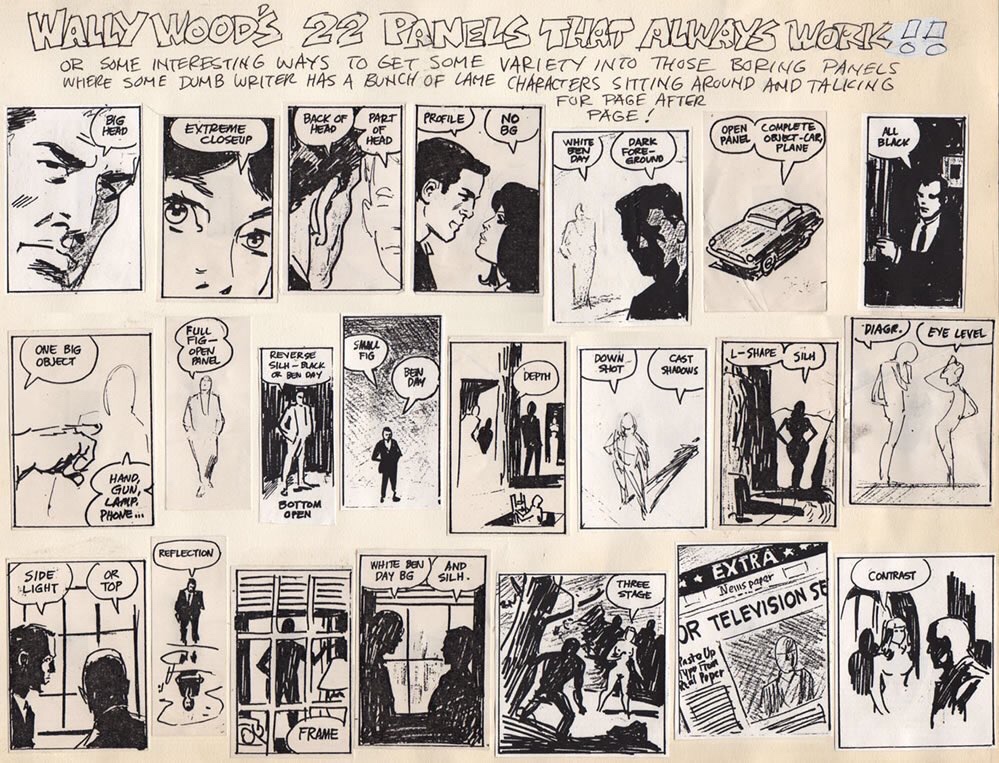
Comics writer Alex de Campi (Blade Runner, Bad Girls) regularly posts tips on creating comics to her Twitter account and filed a posting of the late Wally Wood‘s “22 Panels That Always Work” under “While on the subject of comics scripting: RT to save a baby artist“.
While often ascribed to Wood, artist Rufus Dayglo noted the much-circulated graphic was actually the work of the brilliant Larry Hama, while editing at Marvel (perhaps best known for his work on titles like G.I. Joe there), who complied his mentor Wally Wood’s advice as reference to other artists.
Comic creator Mark Evanier noted in the past that “Panels that Work” originally sprang from created a series of layout techniques sketched on pieces of paper which Wood taped up near his drawing table to help speed up his drawing process. Collected on three pages, these visual notes reminded Wood of various layouts and compositional techniques to keep his pages dynamic and interesting. He would share these with select assistants, including Larry Hama.
Wood’s original, three-page, 24 panel (not 22) version of “Panels” was published with the proper copyright notice in The Wally Wood Sketchbook in 1980. Around 1981, Wood’s ex-assistant Larry Hama, by then an editor at Marvel Comics, pasted up photocopies of Wood’s copyrighted drawings on a single page, which Hama titled “Wally Wood’s 22 Panels That Always Work!!”
“I worked for Wally Wood as his assistant in the early ’70s, mostly on the Sally Forth and Cannon strips he did for the Overseas Weekly,” Hama told Joel Johnson, who owns Larry Hama’s original version of “22 Panels”. “I lettered the strips, ruled borders, swipe-o-graphed reference, penciled backgrounds…
“…The ’22 Panels’ never existed as a collected single piece during Woody’s lifetime. Another ex-Wood assistant, Paul Kirchner had saved three Xeroxed sheets of the panels that would comprise the compilation. I don’t believe that Woody put the examples together as a teaching aid for his assistants, but rather as a reminder to himself. He was always trying to kick himself to put less labour into the work! He had a framed motto on the wall, ‘Never draw anything you can copy, never copy anything you can trace, never trace anything you can cut out and paste up.’ He hung the sheets with the panels on the wall of his studio to constantly remind himself to stop what he called ‘noodling.’
“When I was starting out as an editor at Marvel, I found myself in the position of having to coach fledgling artists on the basics of visual storytelling, and it occurred to me that the reminder sheets would help in that regard, but three eight-by-ten pieces of paper were a bit unwieldy, so I had Robby Carosella, the Marvel photostat guy at the time, make me re-sized copies of all the panels so I could fit them all on one sheet. I over-compensated for the half-inch on the height (letter paper is actually 8 1/2 by 11) so the main body of images once pasted up came a little short. I compensated for that by hand lettering the title.”
Johnson notes Hama left out two of the original 24 panels, as his photocopies were too faint to make out some of the lightest sketches. he then distributed this “elegantly simple primer to basic storytelling” to artists in the Marvel bullpen, who in turn passed them on to their friends and associates… and the rest is both real world and internet viral history (tag #CreatingComics).
Alex’s thread includes Rafael Kaynanan’s version assembled from actual published Wally Wood panels, not just illustrative thumbnails.
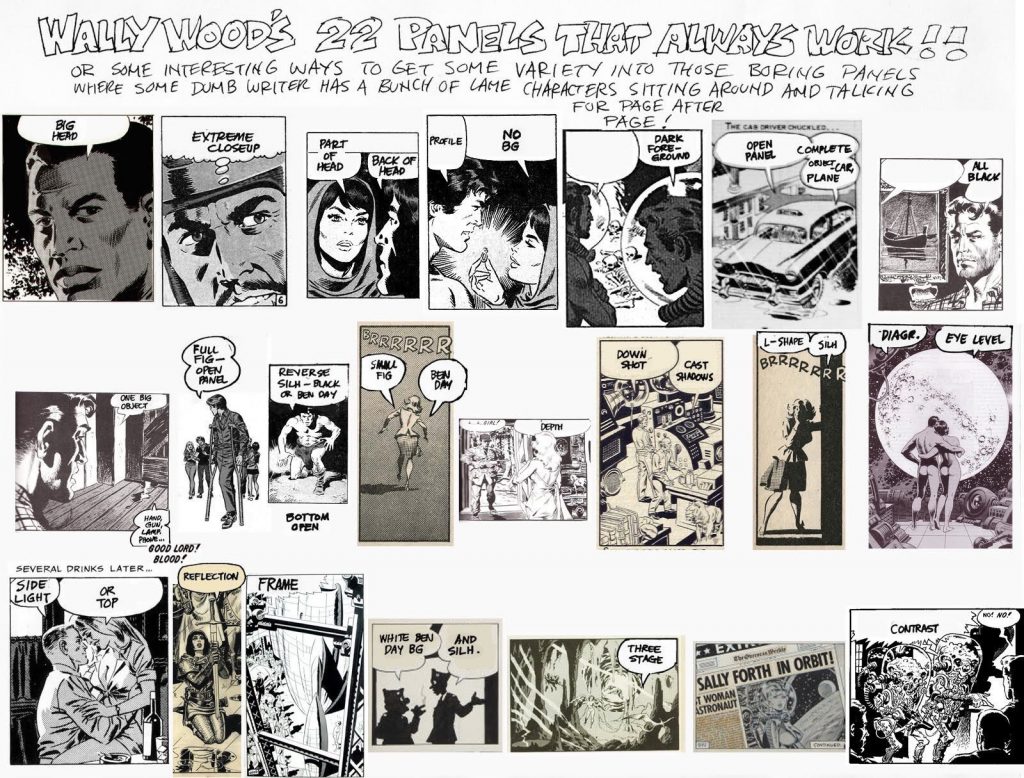
This reminded me that the Wallace Wood Estate had previously offered this nifty guidance to great comic storytelling, ideal for the wall of any comic creators’s studio, as a poster. They still do…
To find out how to get one of these posters, measuring 11″ x 17″, private message them via their Facebook page. (They are more active there than on Twitter). The posters cost $20, including postage within the US. They can discount for quantity/educator orders.
This poster is great as a present for any and every storyteller.
“I reference this all the time,” commented artist Becky Cloonan, while artist Christine Larsen tweeted “I hand this out to my students at the beginning of each semester”.
You should definitely consider following Alex on Twitter, not only for news of her many projects, but many Creating Comics tips, both her own observations and advice, such as this recent thread on conservation of camera angles citing Steve Dillon, and retweets, too, such as this thread on the use of photo reference from the @ArtofCoop. Invaluable!
Earlier this year, she also took part in this thought-provoking 2000AD Thrillcast with 2000AD editor Matt Smith, discussing ways to reach younger comic readers. Well worth a listen, in my view.
• Find the Wallace Wood Estate on Facebook
(Please be advised, if visiting, of some ‘adult’ content examples by Wood)
• Follow Alex de Campi on Twitter @alexdecampi
Recommended Reading
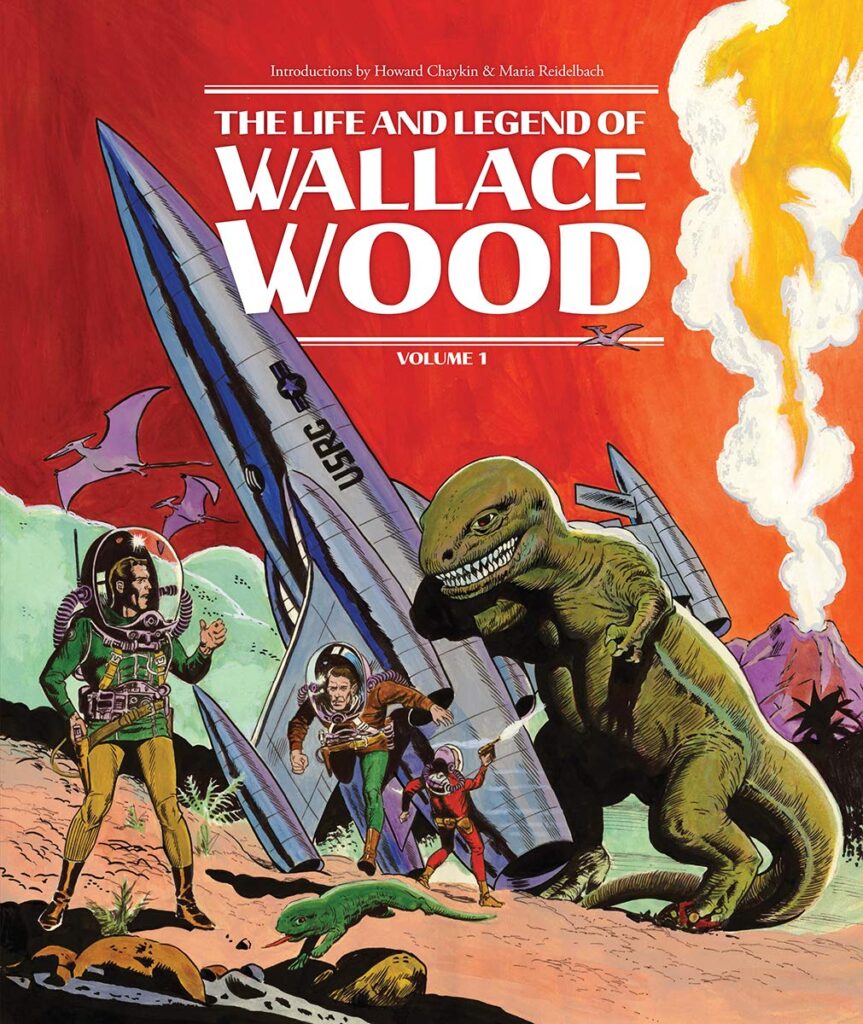
The Life and Legend of Wallace Wood Volume 1
by Bhob Stewart
Published by Fantagraphics
ISBN: 978-1606998151
• Available as a digital edition here from AmazonUK (Affiliate Link) – hardcover copies are expensive!
Who was Wallace Wood? The maddest of all the MAD artists? The man behind Marvel’s Daredevil? The pioneering publisher behind Witzend? For the first time, see inside his world. This is an incisive look back at the life and career of one of the greatest and most mythic figures of cartooning. Edited over the course of 30 years by former Wood assistant Bhob Stewart, His World is a biographical portrait, generously illustrated with Wood’s gorgeous art as well as little seen personal photos and childhood ephemera.
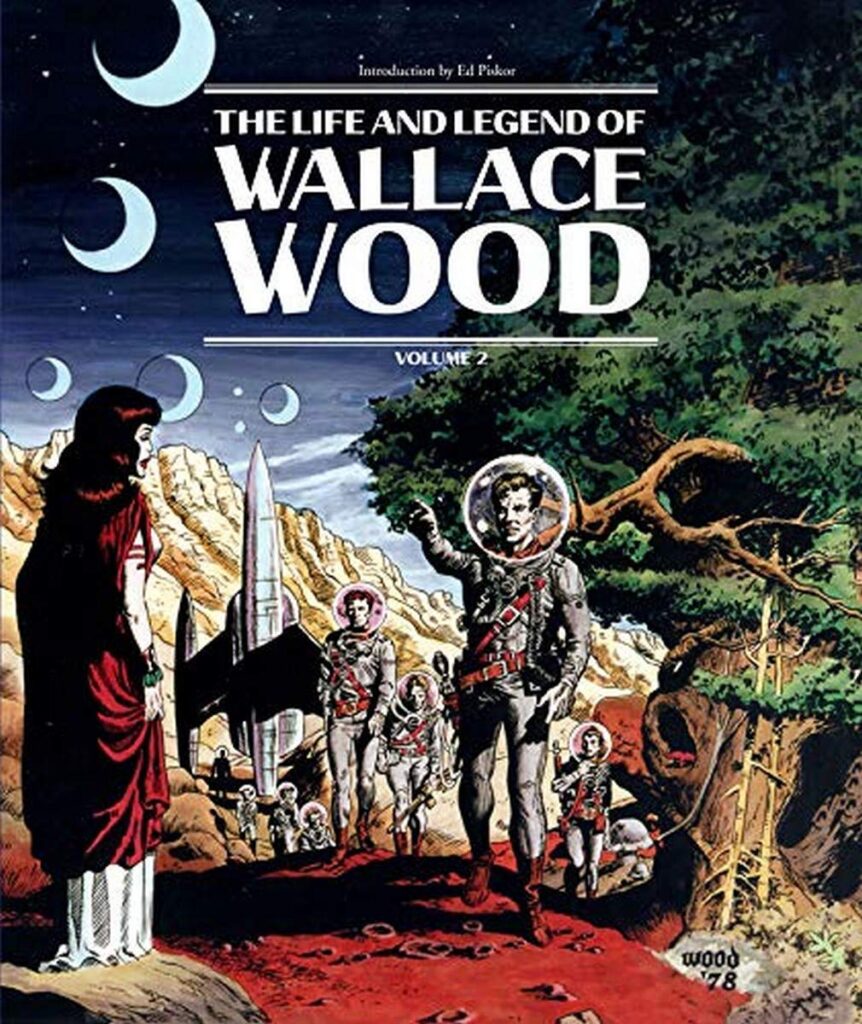
The Life and Legend of Wallace Wood Volume 2
by Bhob Stewart
Published by Fantagraphics
ISBN: 978-1683960683
Available as a digital edition here from AmazonUK (Affiliate Link)
Bursting with a cornucopia of gorgeous artwork and photos, this second of two volumes of the Eisner Award–nominated The Life and Legend of Wallace Wood also features the vivid personal recollections of the friends, colleagues, and assistants who knew him best. This volume completes this revealing, intimate portrait of the brilliant but troubled maverick comics creator (EC Comics, MAD, Daredevil, T.H.U.N.D.E.R. Agents, witzend, The Justice Society of America, The Wizard King).
Contributors include Larry Hama, John Workman, Trina Robbins, Paul Krassner, Flo Steinberg, Tom Sutton, Bill Pearson, and Paul Levitz. Professor Ben Saunders reveals the meticulous handcrafted wizardry that made Wood’s most famous story, “My World” possible.
A special tribute gallery includes artwork by Robert Crumb, Daniel Clowes, Dave Sim, Drew Friedman, and others. Introduction by Eisner Award–winning writer/artist Ed Piskor.
Bhob Stewart (born 1937, Kirbyville, Texas, died 2014, Plymouth, Massachusetts) divided his time between mass and fan media. He was chiefly a writer and editor, although he also drew and acted. He is best known for founding one of the first comics fanzines, EC Fan Bulletin, in 1953; for coining the term “underground comics”; and for art-directing the Hugo Award-winning science fiction fanzine Xero. Stewart invented the Wacky Packages trading card series for Topps, and wrote comics for clients such as Marvel and Heavy Metal. He worked in Wallace Wood’s studio for a time, and became the de facto steward of the influential EC cartoonist’s legacy. Co-author of Scream Queens with Calvin Beck, he edited the Mad Style Guide, and co-edited the seminal underground comics tabloid Gothic Blimp Works?. As an educator, he taught courses in Boston and at the School of Visual Arts in New York.
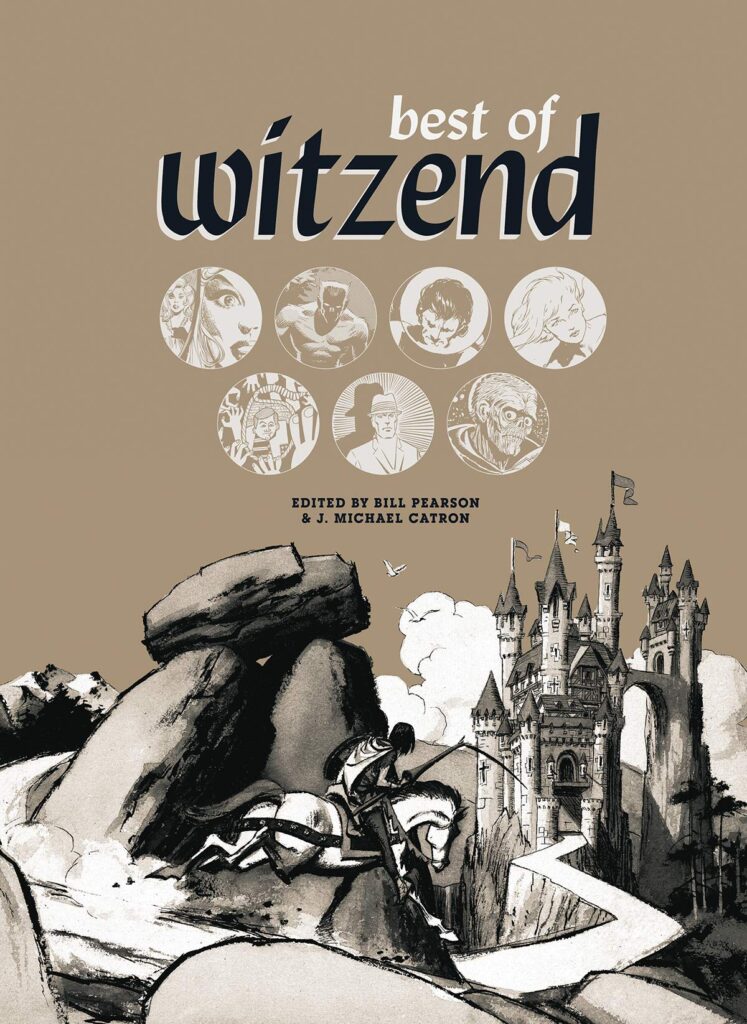
The Best of Witzend
by Wallace Wood, Art Spiegelman, Al Williamson
Published by Fantagraphics
ISBN: 978-1683961154
Available as a hardcover and digital edition here from AmazonUK (Affiliate Link)
Fed up with the formulaic restrictions, censorious nature, and onerous denial of creator’s rights in mainstream comics, cartoonist Wallace Wood created and published his own magazine – witzend. Witzend immediately became a cauldron of bubbling creativity for Wood and his cartoonist friends to produce their own personal work. Fantagraphics published the collected witzend in 2014. It sold out immediately.
The Best of witzend is a 280-page distillation of that publishing milestone, curated by Wood’s longtime assistant and successor as witzend editor and publisher, Bill Pearson.
Wood’s “Panels That Always Work” is copyright Wallace Wood Properties, LLC as listed by the United States Copyright Office which assigned the work Registration Number VA0001814764
The founder of downthetubes, which he established in 1998. John works as a comics and magazine editor, writer, and on promotional work for the Lakes International Comic Art Festival. He is currently editor of Star Trek Explorer, published by Titan – his third tour of duty on the title originally titled Star Trek Magazine.
Working in British comics publishing since the 1980s, his credits include editor of titles such as Doctor Who Magazine, Babylon 5 Magazine, and more. He also edited the comics anthology STRIP Magazine and edited several audio comics for ROK Comics. He has also edited several comic collections, including volumes of “Charley’s War” and “Dan Dare”.
He’s the writer of “Pilgrim: Secrets and Lies” for B7 Comics; “Crucible”, a creator-owned project with 2000AD artist Smuzz; and “Death Duty” and “Skow Dogs” with Dave Hailwood.
Categories: Art and Illustration, Audio, Books, Comic Art, Comics, Creating Comics, downthetubes Comics News, downthetubes News, Links, Other Worlds
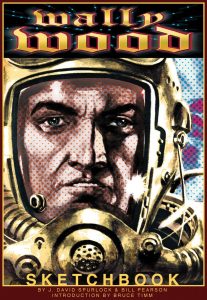
A good reminder for anyone involved in any form of art work. I had a similar aide memoire when taking photographs for stock photo libraries; there it was important to leave blank areas for text. What does “BEN DAY” – in more than one panel – mean?
Named after illustrator and printer Benjamin Henry Day, Jr., (son of 19th Century publisher Benjamin Henry Day), the Ben-Day dots printing process, was used to colour comics for many years in the US. It’s a technique dating from 1879 and US pulp comic books of the 1950s and 1960s used Ben-Day dots in the four process colours (cyan, magenta, yellow and black) to inexpensively create shading and secondary colours such as green, purple, orange and flesh tones. There are links to a terrific series of articles here on an old post https://downthetubes.net/?p=32823
Thanks John, for pointing me in the direction of the Ben Day dots articles. I am reading them with interest. They remind me of when I removed or replaced backgrounds in 10″ x 12″ black and white prints before rephotographing them.
I imagine Day was well known in America at the time Warhol was famous there and in the UK. It seems his style just did not cross the Atlantic.